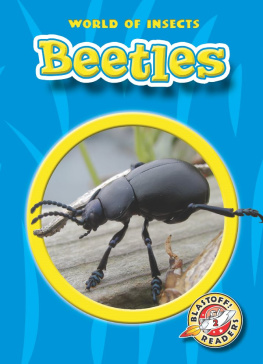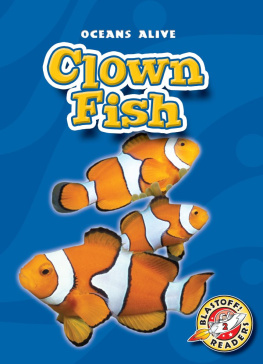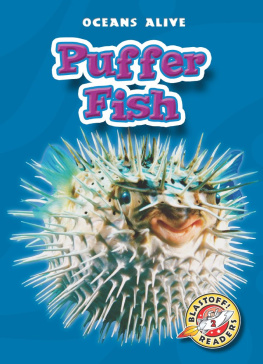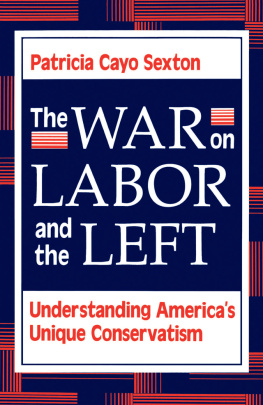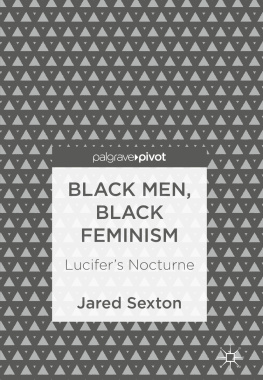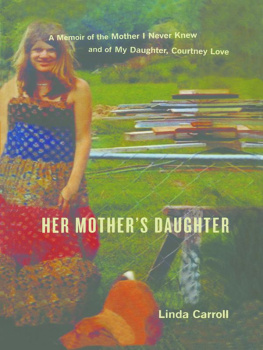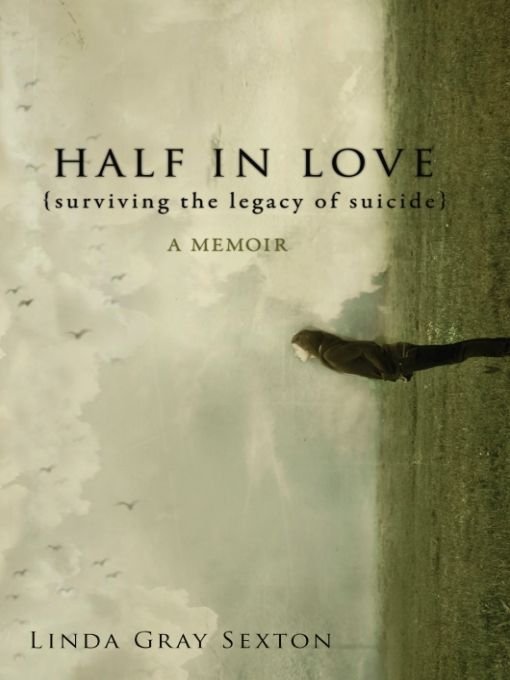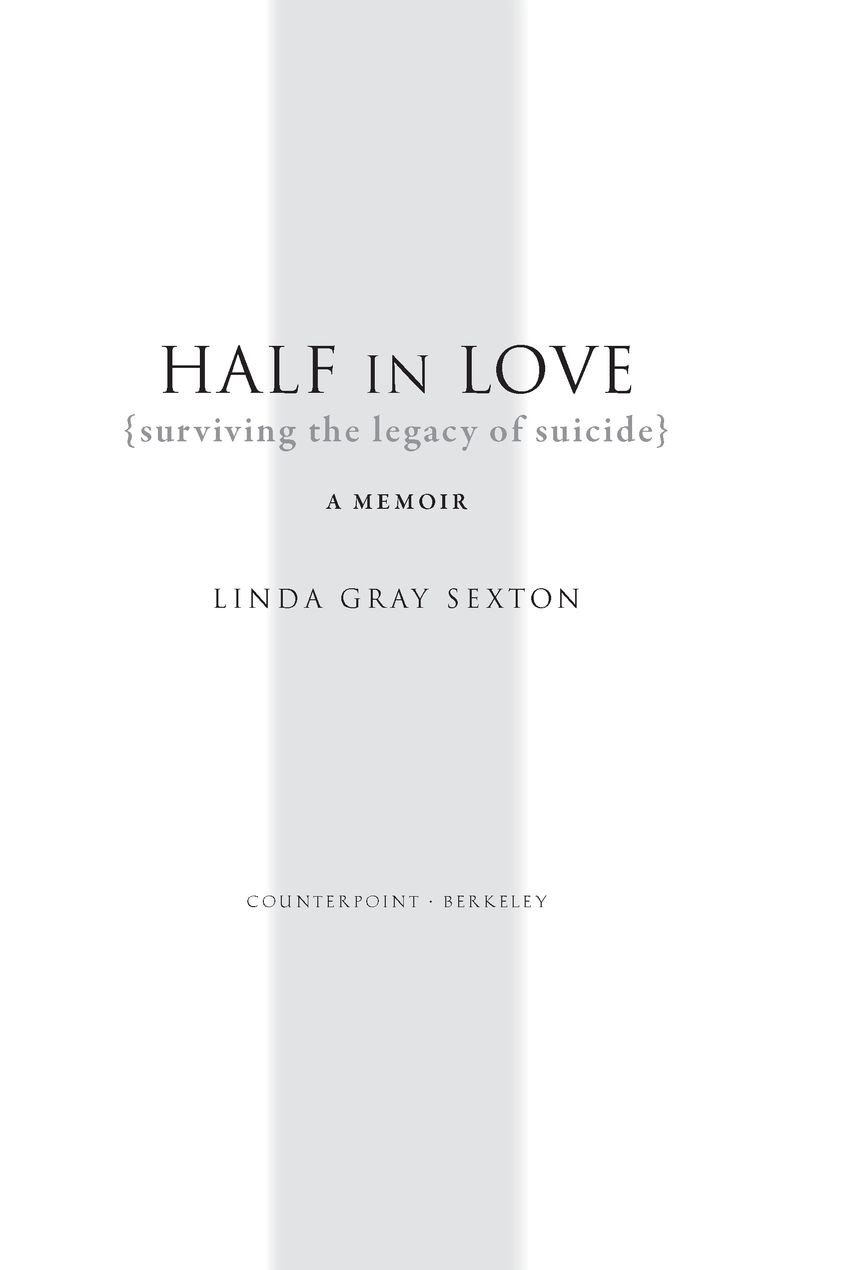Table of Contents
ALSO BY LINDA GRAY SEXTON
NONFICTION
Anne Sexton: A Self-Portrait in Letters
Between Two Worlds: Young Women in Crisis
Searching for Mercy Street: My Journey Back to My Mother, Anne Sexton
FICTION
Rituals
Mirror Images
Points of Light
Private Acts
To Brad,
for remaining resolute
Darkling I listen; and for many a time
I have been half in love with easeful Death,
Called him soft names in many a mused rhyme,
To take him into the air my quiet breath;
Now more than ever it seems rich to die,
To cease upon the midnight with no pain.
JOHN KEATS ODE TO A NIGHTINGALE
PREFACE
SOMETIMES, EVEN MY bones resonate with the melodies of my childhood.
Ebullience and depression; love and warmth; the frightening separations and the joyous, if fragile, reunions. This is how I come to remember, simply because the old rhythms will always reverberate, always remain.
Long ago, I graphed the fevers of my mothers innumerable attempts at suicide. In 1974, when I was twenty-one and a college senior, my mother committed suicide after having tried many, many times. In 1994, when I was forty, I published a memoir, Searching for Mercy Street: My Journey Back to My Mother, Anne Sexton, about our complex relationship.
In 1997, as I turned forty-fivethe same age my mother had been when she diedmy world fractured in ways I could never, ever, have foreseen. I found myself drawn into my own vortex of depression, desperate for relief from the intense interior pain that obliterated nearly every waking moment. I tried once, twice, three times, to kill myselfeven though I was a daughter, a sister, a wife and, most importantly, a mother.
Before my mothers death, she appointed me literary executor of all her posthumously published work, as well as the guardian of the enormous archive that required a home in a university library. Searching for Mercy Street dealt with my maturing as a woman and as a mother, as well as the acceptance of my sorrow that my mother had found parenting my sister and me to be so onerous. The book was my attempt to reach out to her, after her death, despite her many problems. With the arrival of my two sons, I discovered a fresh understanding of, and compassion for, how difficult being a parent truly is, even when it is not complicated by mental illness. In all these ways, I came to know my mother, this time as an adult.
Searching for Mercy Street was only a prelude. That book focused on coming to terms with my mothers life, while I had yet to learn how to come to terms with my mothers death. I needed to confront and disentangle myself from the strong tentacles her suicide had attached to my life. I needed to confront my own struggle with depression, bipolar illness, and our familys history of successful suicides. This struggle reflects the emotional, and perhaps biological, legacy that was passed on from my mother to me. It illustrates how I came to make decisions as a fifty-year-old woman, for myself and my family, away from the magnetism of my mother and her powerful sphere of influence. What a shock to discover myself following the same terrible path she had walked, despite all my determination that this should and would not happen. Not only for myself, but for my children.
While I knew first-hand that depression can leave entire families helpless, it stunned me to learn that, in the United States alone, someone kills himself every seventeen minutes. I realized that I was not alone in the tractor beam of the disease. I thought about the many others there were, trapped alone under the bell jars of their depression and suicidal urgesand their families, prisoners as well. I hope this book speaks for them all.
With the help of a family that strove to forgive and accept, with the benefit of excellent psychotherapy and the best of modern medications, I was able to break the cycle of self-destruction upon which I had been raised. One day, it occurred to me that I had outlived my mother, and so had stopped the familial battle with suicide. I had lived to see my sons surpass the age I was when my mother took her own life. I had not abandoned my children as I had been abandoned. I was a mother who lived, despite it all. At last, I had moved into my own pioneer territory.
PART 1
{the story}
Do not go gentle into that good night.
Rage, rage against the dying of the light.
DYLAN THOMAS
{a terrible act}
IN DECEMBER OF 1997, I fell into a pit of loneliness and sorrow and couldnt climb out. I couldnt talk with those I loved about my grief or my despair, so afraid that by speaking about such things, I would make them even more real. I worried, unconsciously, that even if I described the pain wrapped around my heart, I would not be heard. I worried, consciously, that othersno matter how closewould perceive me to be preoccupied with myself in unattractive ways. Who could really understand how I felt and refrain from making negative judgments about it all?
I had feared the approach of my forty-fifth birthday for years; my mother had killed herself the month before her own birthday on that forty-fifth year of her life. Now here I wasjust six months away from my ownon a slippery road in the rain, a road slick with curves and no guard rail. No longer could I imagine, or believe, that I would outlive my mother by besting the number of years she, and now I, experienced as so achingly turbulent.
I had been hiding my depression fairly wellfollowing each days routinesbut still it gnawed away in my gut like a wolf in a trap, and at last it gathered itself for the attack. At my younger sons bar mitzvah in October, I had gotten drunk in public, but no one seemed to notice anything strange, perhaps because I had been keeping my drinking private. Alcohol helped keep me quiet, sedated, and isolated.
That particular night in December, my husband, Jim, had already phoned me from his hotel room on the East Coast, where he was traveling for business. I reassured him that all was well, and then went into the kitchen to pour another martini, which was really just gin, straight up and crowded by a raft of olives. As I came back to the bedroom from the kitchen, I stopped at the oil portraits of my mother and her mother that hung in my back hall; originally they had been mounted on facing walls in a front room in my grandmothers house, where no one could avoid them.
For the first time in my life, I envied my mother for the solution she had found in order to quell the pain of her depression. For the first time in my life, my emotions pushed aside all concern for the family who would remain if I joined my mothereven though I, too, had once been part of such a family so abandoned. I knew well the agony of that rejection.
My thoughts of suicide did not mean that I didnt care about these very important people in my life: it was more as if the pain that accompanied my depression had moved onto a new plain, and, in my confusion, it seemed to require a new and different sort of release.
As I stood in front of the portraits, I toasted my mother for the job she had done. You really knew how to do it, I told her with admiration. You got it right. And in that momentwhen all I knew warped and slid out of time, out of sync with all I had previously believedI saw her action as courageous. How had she managed it? Having done extensive reading on the subjectthough I had not let myself wonder why I was doing such readingI now knew how hard it was to kill oneself. Pills easily vomited, hanging gone awry, monoxide poisoning interrupted at the last minute.


